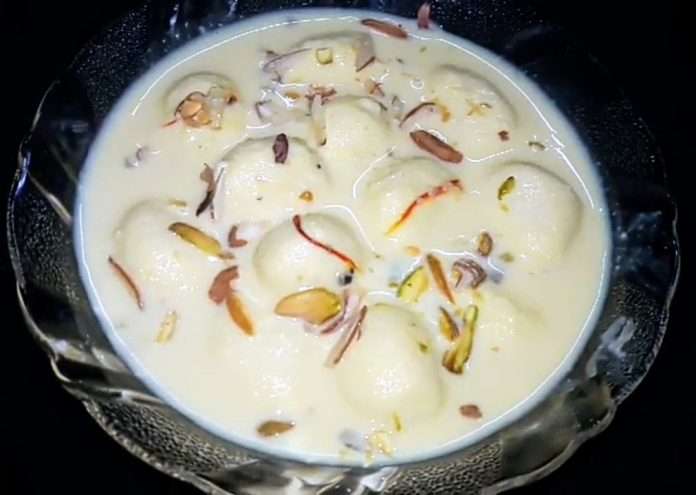On the day of Niladri Bije, when He returns to Sri Mandira, better known as Bada Deula (Big Temple), Mahaprabhu Jagannath gives rasagola to His spouse, goddess Lakshmi, to placate her; this is a sweet she never prepares in her kitchen in Bada Deula. But despite this eminently enviable connection, rasagola is not the distinctive sweet of Puri; khira is, despite its not being part of the Chpana bhoga system of Lord Jagannath.
Whether the word khira (pronounced as khiraa) derives from theword khiri (Hindi kheer) or not, the two objects they refer to, namely, khira and khiri would appear almost alike to the one has no patience for niceties. Khira, like khiri, is made of milk. It is basically sweet, much-thickened milk, thickened by boiling for a long time.
A considerable amount of home-made cheese or sweet, deep-fried cakes made of the same (pronounced chenaa taadiaa) are often added to it for variety and taste. Khira does not have the elegant look of khiri, pedantically called payasa; neither does it have its aroma. No wonder, it hasn’t become a marketable dish – as yet, at least.

Khira is a Puri dish, although one doesn’t get it in hotels and restaurants in this temple town. It is extremely unlikely that it is available anywhere else in the State. Interestingly, “khira” in the sense of the sweet dish under reference, does not even occur in the exhaustive, three-thousand-page Odia dictionary, entitled “Ajanta Odia Abhidhan”. This uncelebrated stuff is the celebratory sweet dish of “inner” Puri, to be precise.
Following the linguist and writer Bijaya Prasad Mohapatra, one could justifiably think of this temple town in terms of inner Puri and outer Puri. Inner Puri is where people mostly connected with the temple live and it is the area around the majestic Bada Deula. Outer Puri is an extension; this is where the “outsiders” live: government employees, retirees, practitioners of modern professions, etc.
Tourists, as distinct from traditional pilgrims, stay in this part of the town. In spite of this, inner Puri and outer Puri can be better thought of today as more cultural than spatial constructs. For the people of the outer Puri, generally pitiably over-conscious about their calories and cholesterol, this rather heavy-to-digest khira is once-in-a fortnight luxury dish.
As the celebratory sweet dish, khira goes with meals of any kind: rice and dal, roti or khali roti with dalma, puri and dalma or sabji (vegetable dish), sweet and spiced, crushed and sweetened flattened rice (cudaghasa) and dalma. People are so fond of it that it often appears that the main meal is just an excuse for having khira. In a feast, when khira is served, connoisseurs just set aside other foods on their leaves (they even fondly ask a friend to do so, if he hasn’t already) and concentrate on it. If there is rice on the leaf, one makes a wall of it for khira.
Unlike rasagola, which one can roll in one’s mouth so as to savour it, it has to be eaten up really fast, so that it doesn’t flow out of the leaf. At a feast, it is served at least twice, sometimes even three times, if the host is generous and the guests, special. One must eat it with one’s fingers; no spoons (and no cups, either) are provided in a traditional community feast. Things are changing, though. For an oldie like me, if you eat khira in a cup with a spoon, you are being insensitive to the tradition.
Those hosts who simply cannot afford, go for a substitute – crushed ripe bananas, for example. Those who can barely afford it, have their khira rather thin, with very little cheese or cheese cake in it, or none at all. The well-to-do put a lot of these in their little extra-thick khira; especially those among them who love to eat and love to feed. In a community or group feast, if one is a special guest, one is served less khira and more cheese or cheese cakes.
But one does not necessarily have to be an influential or a powerful person to be treated as a special guest, especially in inner Puri; here people still value warmth, goodwill and personal relationship. In a community feast here, a friend of the host from the outer Puri, is usually treated as a special guest. That was how I, a non-entity, used to be treated, when I participated in such feasts, to which I was invited, having among the servitors in the Jagannath Temple, some of my closest friends.
Unlike laddu and khiri, and surprisingly rasagola, it is a completely “secular” dish. Without the inviting look of the rasagola or the sandesh, and its hard-to-digest disrepute, this great cultural dish is unlikely to attract the uninitiated. Dozens of sweets have found mention in Odia literature during the last five centuries – ever since the great poet Sarala Das – including chena tadia – but as for khira, the story is different.
It would need considerable research to find out if it has been mentioned at all. With low packaging value, khira is most likely to remain a local dish. Which is fine, as far as I am concerned: this would make it the ultimate dish of Puri’s culinary identity! No one would or can contest if the state government seeks the GI tag for this wonderful dish.

For the best khira, you must go to the narrow lanes in the inner Puri. For the best of the best – in the opinion of some local khira experts – one used to go to the two sweet shops on the right-hand corner of Lakshmi Bazar if one was entering it from the Grand Road. Adjacent to Singhadwara (The Lions’ Gate).
That was two years ago. Beautification of Puri, which is a modernization project and which has started, understandably, as some would say, from the area in front of the Temple, has changed the landmarks around the Temple. The outer Puri has made inroads into the inner Puri. The two sweet shops have disappeared from that corner.
It does not matter where they have relocated themselves. Things will not be the same. Not for us, at least. On the day of Niladri Bije, nowadays also celebrated as Rasagola Divasa, devotees would buy from them lots and lots of rasagolas and offer them to the Deities on Their rathas. That we will not see anymore. Modernization has sent that into memory.
(The views expressed are the writer’s own)

Prof. B.N.Patnaik
Retd. Professor of Linguistics and English, IIT Kanpur
Email: [email protected]
(Images from the net)

